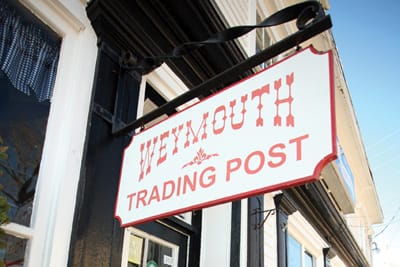Atlantic Canada's oldest general store was a forerunner to the modern mall-and is still open for business.
LIKE THE TIDAL waters of the nearby Sissiboo River, the Trading Post in Weymouth, NS, has had its ups and downs. The high water mark may have come and gone, but after 150 years the building is still standing, and it's still a general store--an accomplishment that marks it as the oldest continuously running general store in Atlantic Canada, if not the country.
Colin Campbell III built the store in the late 1850s, the beginning of a period known in Nova Scotia as the Golden Age of Sail. It was a time of prosperity, when Canada's merchant fleet was one of the largest in the world, and tall-masted sailing ships carried millions of loads of lumber from busy seaports like Weymouth and Yarmouth to destinations in the US, the West Indies and the British Isles.

For merchant trader and ship builder Colin Campbell, the period might just as easily have been called the Golden Age of Sales. His ships left Weymouth with lumber and returned laden with barrels of salt, chests of tea and hogsheads of molasses-precious cargo that was inventoried and distributed from his general store.
Business was still booming when Colin's son, George Douglas Campbell took over the store in 1881. G.D. Campbell & Co became a mainstay in the community-a forerunner to the modern mall-with separate entrances to a grocery store, dry goods store, hardware store, and a mercantile bank, which would evolve into one of the first Royal Banks in Canada.
In those days customers came on foot, by boat, and in buggies and wagons. They came to shop, to socialize and to do their banking; they left with dry goods, china, and groceries-most of which arrived on ships at the Weymouth wharf.
 In time, the wharf would become obsolete. Goods would travel by land instead of sea, and the river would lose its importance. But the tide was slow to turn in Weymouth-there were still three-masted schooners and small coastal trading ships on the Sissiboo River in the 1920s.
In time, the wharf would become obsolete. Goods would travel by land instead of sea, and the river would lose its importance. But the tide was slow to turn in Weymouth-there were still three-masted schooners and small coastal trading ships on the Sissiboo River in the 1920s.
Margaret Barnard, G.D. Campbell's granddaughter, recalls the wharf was a busy place. She also remembers the general store: the pulley that raised and lowered a large cover for a wheel of cheese, the vault that was left behind in 1907 when the bank moved across the street, the storage space on the second floor where she sat and read magazines.
"In the winter it wasn't exactly warm," she says.
When G.D. Campbell died in 1930, Margaret's father, Glidden Campbell, and his brother, George Douglas Jr. (Dougal) took over the store. With the Great Depression on the horizon and the embers still glowing from a fire that had devastated the town, their timing couldn't have been worse.
Margaret remembers her father was always climbing up on the store's roof to make repairs. "People would call and say, 'Mr. Campbell's on the roof again,'" she says with a laugh.
> "He was thrifty," recalls Margaret's younger brother, Ian.
"There was a hill between our house and the store…he would turn the car off at the top and coast the rest of the way."
The store did some coasting of its own in the aftermath of the depression and again in the war years, and finally in 1959, the Campbell family sold it to Grantham Bell, from Yarmouth. For the next 40 years, Grantham changed almost nothing but the name of the store, even refusing to put a handrail on the stairway to the second floor because the Campbell family never had one.
"He stacked up cans of paint for people to grab hold of," says Dora Bell, Grantham's widow.
 When Dora married Grantham in 1979, there were more than a few surprised faces in Weymouth. "He was an old bachelor and I was an old maid," she says, laughing.
When Dora married Grantham in 1979, there were more than a few surprised faces in Weymouth. "He was an old bachelor and I was an old maid," she says, laughing.
She managed the store's stock of pots and pans and dishes on the second floor. "If someone wanted a nice wedding present they came to us. We had the best quality china, but you'd be in the back looking for something and you'd just about freeze."
It wasn't the china that first attracted one of the store's current owners. As a child, Louise Mullen would stop there to buy candy on her way home from school. Later, as an adult, she would stop to buy groceries on her way home from work.
Louise and her husband, Roger, bought the store from Grantham Bell in 2001. The following year they registered it as a Heritage Property. The Mullens made some repairs, but they're committed to preserving the store's essential character.
On the first floor they've kept the bank vault, the housewares and hardware, and added a flower shop, where horses were once stabled.
The second floor is now devoted to a year-round festive display of Christmas decorations. This is where Margaret Barnard once read magazines, and where Dora Bell kept the fine bone china for wedding presents. It's also where a female colleague of Dora's once knocked a customer down the stairs and into a washtub for getting too fresh.
 Times have changed, but from the wavy glass in the old windows there's still a fine view of the Sissiboo. "That old glass doesn't do much to keep out the wind," says Louise with a shiver.
Times have changed, but from the wavy glass in the old windows there's still a fine view of the Sissiboo. "That old glass doesn't do much to keep out the wind," says Louise with a shiver.
It's even colder on the top floor, but for the history lover it's well worth the chill. This is where employees found an unopened shipping box and inside that box, an antique coal-burning ship's stove made by the Lunenburg Foundry.
"They thought they'd discovered a treasure," says Louise.
Given the number of offers she's had to purchase the little ship's stove it might be a treasure after all, and there may be more treasures on the third floor: the heavy hoist that once hauled up goods through trap doors, the dome for the cheese wheel that Margaret Barnard remembers, a wooden scale for measuring board feet of lumber.
Of course, the real treasure is the store itself. The sailing ships have departed and the wharves where they once rested have decayed and dropped into the water, but the Trading Post is still open for business, and it's still keeping a vigil over the ebb and flow of the Sissiboo.
